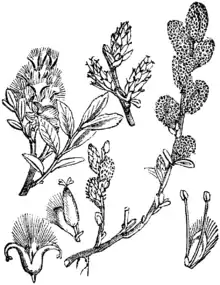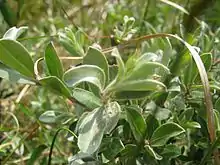Salix repens
Salix repens, the creeping willow, is a small, shrubby species of willow in the family Salicaceae, growing up to 1.5 metres in height. Found amongst sand dunes and heathlands, it is a polymorphic species, with a wide range of variants. In the UK, at least, these range from small, prostrate, hairless plants at one end of the spectrum to taller, erect or ascending silky-leaved shrubs at the other.[2] This wide variation in form has resulted in numerous synonyms.[1]
| Salix repens | |
|---|---|
 | |
| S. repens in flower | |
| Scientific classification | |
| Kingdom: | Plantae |
| Clade: | Tracheophytes |
| Clade: | Angiosperms |
| Clade: | Eudicots |
| Clade: | Rosids |
| Order: | Malpighiales |
| Family: | Salicaceae |
| Genus: | Salix |
| Species: | S. repens |
| Binomial name | |
| Salix repens | |
| Synonyms[1] | |
| |


Distribution
The plant has a Eurosiberian Boreo-temperate range, and is widely distributed around the coasts of western and northern Europe.[3][4]
In the UK, the prostrate forms (ssp. argentea and ssp. repens) are characteristically found on sand dunes, growing close to the water table in dune slacks, as well as in coastal heaths and acid grassland, as well as being found further inland on heaths and moorland. The erect form (var. fusca) occurs in fens. The species becomes more confined to moist or wet habitats in the southern and eastern parts of its UK range, and has been recorded from sea level up to 855 metres (2,805 ft) (in East Perthshire).[3]
Ecology
Dunes containing Salix repens are recognised as being of ecological importance by the EU Habitats Directive. Over 132 Natura 2000 sites are designated for this habitat type. As the water table lowers within the slack, these Salix-dominated habitats (termed Salicion arenariae) may develop either into mesophilous (neither wet nor dry), or xerophilous (dry) communities. The former may contain species such as Pyrola rotundifolia, Viola canina and Monotropa hypopitys; the latter containing Carlina vulgaris and Thalictrum minus.[5][6]
Salix repens provides shelter to other species of plant and animal. Its soft, fluffy seed hairs provide nesting material for songbirds, whilst in autumn there is often a rich assemblage of unusual fungus species growing in its vicinity.[7]
Should the dune slack that the plant inhabits become inundated by an advancing dune, it is able to adapt and change its growth form from erect to prostrate. Losing its erect habit, the plant is able to creep horizontally along the front of the advancing dune and survive the changing conditions.[8]
Studies have shown that mycorrhizal fungal associations may assist Salix repens in expanding the ecological niches it can occupy.[9][10][11]
Hybrids
Creeping willow may hybridise with other Salix species, typically including goat willow (S. caprea) and downy willow (S. lapponum).[12] One especially rare hybrid (S. x angusensis) was discovered on Ainsdale Nature Reserve, Lancashire in 1993. It is a hybrid between three Salix species: S. cinerea ssp. oleifolia x S. repens var. argentea X S. viminalis.[13]
References
- "Salix repens L. — The Plant List". www.theplantlist.org. Retrieved 2017-12-09.
- Meikle, R.D. (1984). Willows and Poplars of Great Britain and Ireland. BSBI Handbook No.4. London: Botanical Society of the British Isles. pp. 140–145. ISBN 978-0901158079.
- "Salix repens | Online Atlas of the British and Irish Flora". www.brc.ac.uk. Retrieved 2017-12-10.
- West, R. G. (2000-04-13). Plant Life of the Quaternary Cold Stages: Evidence from the British Isles. Cambridge University Press. p. 225. ISBN 9780521593977.
- "EUNIS -Factsheet for Dunes with Salix repens ssp argentea (Salicion arenariae)". eunis.eea.europa.eu. Retrieved 2017-12-10.
- "SAC selection - 2170 Dunes with Salix repens ssp. argentea (Salicion arenariae)". jncc.defra.gov.uk. Retrieved 2017-12-11.
- Atlas, NBN. "Salix repens : Creeping Willow | NBN Atlas | NBN Atlas". species.nbnatlas.org. Retrieved 2017-12-10.
- STOMPS, THEO. J. (1915). "The Dunes of Lake Michigan". The Plant World. 18 (8): 205–216. JSTOR 43477467.
- Heijden, E. W. Van der; Kuyper, Th W. (2001-01-01). "Laboratory experiments imply the conditionality of mycorrhizal benefits for Salix repens: role of pH and nitrogen to phosphorus ratios". Plant and Soil. 228 (2): 275–290. doi:10.1023/A:1004850423794. ISSN 0032-079X. S2CID 22296398.
- van der Heijden, EW; Vosatka, M (2000-02-20). "Mycorrhizal associations of Salix repens L. communities in succession of dune ecosystems. II. Mycorrhizal dynamics and interactions of ectomycorrhizal and arbuscular mycorrhizal fungi". Canadian Journal of Botany. 77 (12): 1833–1841. doi:10.1139/b99-178. ISSN 0008-4026.
- Heijden, E. W. van der (2001-01-01). "Differential benefits of arbuscular mycorrhizal and ectomycorrhizal infection of Salix repens". Mycorrhiza. 10 (4): 185–193. doi:10.1007/s005720000077. ISSN 0940-6360. S2CID 10605629.
- "Creeping Willow, Salix repens - Trees and shrubs - NatureGate". www.luontoportti.com. Retrieved 2017-12-10.
- Meikle, R.D.; Robinson, N.D. (2000). "A new record for Salix x angusensis (Salicaceae) Rech. f. from Ainsdale Sand Dunes National Nature Reserve, S. Lancs. v.c. 59". Watsonia. 23: 327–330.
External links
| Wikimedia Commons has media related to Salix repens. |